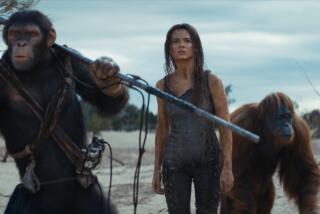Movie review: ‘Rise of the Planet of the Apes’
“Rise of the Planet of the Apes” does it right. Smart, fun and thoroughly enjoyable, it’s a model summer diversion that entertains without insulting your intelligence. Adroitly blending the most modern technology with age-old story elements, it’s also an origin story that answers the question that’s been hanging in the air since 1968: How did it happen that apes rule?
That year’s Charlton Heston-starring “Planet of the Apes” (based on a novel by Pierre Boulle) posited a world where simians were in charge and people were in cages. The film was popular enough to spawn four sequels as well as a Tim Burton-directed remake, but this latest venture, which reveals how it all began to go bad for us and good for them, takes things to a whole other level.
“Rise of the Planet of the Apes” is as good as it is partly because it’s strong in the areas all films, not just summer blockbusters, should be. It’s effectively written by the team of Rick Jaffa & Amanda Silver and well acted both by stars like James Franco and John Lithgow and supporting players like the protean Brian Cox.
It’s not Caesar, future godfather of all apedom, who we meet first, but his mother, Bright Eyes. She is captured in a teeming jungle and brought back to San Francisco to be part of an experiment being run by a determined scientist (an appropriately earnest Franco) employed by the pharmaceutical corporation Gen-Sys.
That would be Will Rodman, who has been working for 51/2 years on a drug that would enable brain cells to repair themselves and thus be a cure for Alzheimer’s. When his latest serum, ALZ-112, makes a startling improvement in Bright Eyes’ cognitive skills, Will can barely contain his excitement.
But before crucial human testing can begin, something unfortunate happens, and the project is shelved, which is especially hard on Will because his father (Lithgow) is suffering from dementia and going from bad to worse.
Circumstances conspire, as they tend to do in movies like this, to insure that Will spirits Bright Eyes’ son Caesar out of the lab and raises him at home. He also can’t resist getting his hands on enough ALZ-112 to begin injecting the chimp as well as his father. The results are remarkable at first, but unlike the people on screen (which include Frieda Pinto’s comely vet and Cox’s ape abuser), we in the audience know that persistent Will is playing with fire.
British director Rupert Wyatt’s previous feature was the excellent prison-break drama “The Escapist,” but he proved to be a shrewd choice to make a film about an entire species breaking free of eons of restraint, one that includes some of the most potent species versus species conflict since Alfred Hitchcock’s “The Birds.”
A director who knows how to bring drive and momentum to material he connects with, Wyatt works with editors Conrad Buff and Mark Goldblatt (both veterans of several James Cameron projects) to create a crackerjack sense of pace. And cinematographer Andrew Lesnie, who shot the “Lord of the Rings” films, gives “Rise of the Planet of the Apes” an exciting wide-screen feeling while providing numerous bravura visual moments.
Lesnie’s task was complicated by the film’s extensive use of state-of-the-art computer technology, an exceptional combination of motion capture and performance capture (for facial expressions) that makes the 150 or so digitally created apes look remarkably real.
Visual effects supervisors Joe Letteri (a four-time Oscar winner) and Dan Lemmon (both with New Zealand’s Weta Digital) utilized technology pioneered by “Avatar” and took it further. This is the first time, we’re told, that performance capture has been employed in the direct sunlight of the real world rather than the confines of a sound stage.
All this technology wouldn’t be as dazzling as it is without the work of the actors (some from Cirque du Soleil) who wear the motion capture suits, especially the redoubtable Andy Serkis, Gollum in the “Lord of the Rings” trilogy. He plays Caesar, who goes from being a cuddly “Project Nim” type chimpanzee to He-Who-Must-Be-Obeyed.
For all its visual razzmatazz, which includes thrilling sequences shot on a football field-sized replica of the Golden Gate Bridge constructed outside of Vancouver, “Rise of the Planet of the Apes” can be subtle as well, including a tiny visual reference to the 1968 film that will go unnoticed by those who haven’t seen the original.
Subtlety is also the watchword when it comes to the facial expressions of Caesar and the other apes, a group that includes an orangutan named Maurice (Karin Konoval), whose convenient knowledge of sign language makes it possible for the audience to get a window into Caesar’s mind as the two communicate.
Caesar’s facial expressions, which include the unnerving stare of cold calculation that is a highlight of the film’s trailer, is the key to following this very special chimpanzee’s complex and conflicted mental states.
This is one sophisticated chimpanzee, and one sophisticated summer blockbuster as well.
More to Read
The biggest entertainment stories
Get our big stories about Hollywood, film, television, music, arts, culture and more right in your inbox as soon as they publish.
You may occasionally receive promotional content from the Los Angeles Times.











